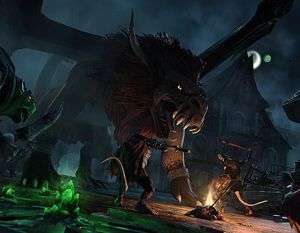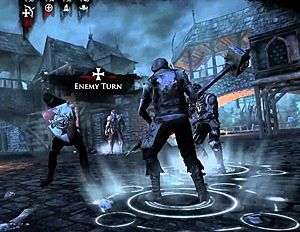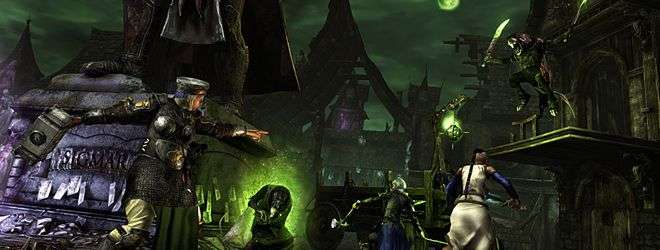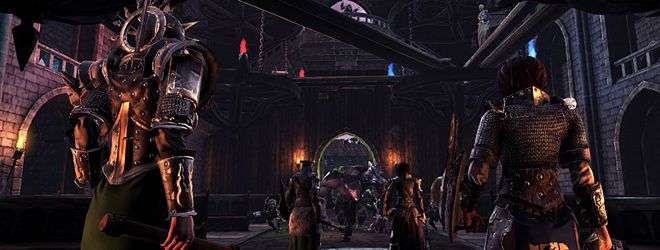Mordheim: City of the Damned – Review
by Mark
|
 It’s been a big year for the Warhammer Fantasy universe as its unique and grim setting sees outings in various video game guises. Recently, developer Fatshark released its take on Warhammer, with its Left4Dead-style game, Vermintide, which sees bands of players battle against hordes of humanoid rats known as Skaven. Meanwhile, strategy powerhouse Creative Assembly are working on a Warhammer Fantasy strategy game on the massive scale you would expect from the Total War series, and this is expected to be released early next year. It is in this slightly saturated market that Focus Interactive and developer Rogue Factor launch Mordheim: City of the Damned, a turn-based strategy game based on Mordheim, the classic table-top game from Games Workshop.
It’s been a big year for the Warhammer Fantasy universe as its unique and grim setting sees outings in various video game guises. Recently, developer Fatshark released its take on Warhammer, with its Left4Dead-style game, Vermintide, which sees bands of players battle against hordes of humanoid rats known as Skaven. Meanwhile, strategy powerhouse Creative Assembly are working on a Warhammer Fantasy strategy game on the massive scale you would expect from the Total War series, and this is expected to be released early next year. It is in this slightly saturated market that Focus Interactive and developer Rogue Factor launch Mordheim: City of the Damned, a turn-based strategy game based on Mordheim, the classic table-top game from Games Workshop.
Much like its turn-based table-top brethren, Mordheim focuses on battling warbands drawn to the city by the promise of loot and prestige or the whispering of their gods. As the masses gathered in Mordheim to welcome what they thought was the return of their ancient heroic god, a twin-tailed comet strikes the city killing thousands and littering the streets with a strange crystal known as Wyrdstone. This stone has a number of interesting properties, and as word spreads factions begin paying huge amounts of money to get their hands on some of this stone. Warbands descend on the broken city battling for the resource in streets now rampant with the very worst the world has to offer. So it becomes the player’s job to manage one of these armed groups, the human mercenaries, the cunning Skaven, the pious (and heavily armoured) Sisters of Sigmar, or the mutated warriors of the Cult of Chaos. Each group has its own unique campaign which generally involves unique mission objective, such as the Human Mercenaries mission to collapse some of the cities tunnels, cutting off the Skaven.
Once a faction has been selected, the player is taken to the Warband screen, which is the central hub around which the rest of the game sits. From here you have the option to make changes to your warbands skills and equipment, shop for new items, or deliver Wyrdstone to your benefactor for a tidy profit. The campaign itself is played day to day, so with only one mission available per day and the troops requiring payment for each mission they attempt, the early game becomes a careful balance of your finances. Attempting missions brings in loot and Wyrdstone which provides gold, but also at the (fairly high) risk of injury or death of your warriors. Injury requires additional payment of gold to healers and then days of recovery time, often taking a unit out of a few fights.
 Each warband is broken down in to a number of unit types; the leader is exactly that – they are typically better skilled and come with higher starting stats. Hero units are unique characters with specific special abilities, such as the spell-flinging human warlock or the backstabbing Skaven Night Runner. The hero units generally pack a hell of a punch or provide support to the henchmen, who are the backbone of your band of warriors. The henchmen are your redshirts – generally replaceable, but they will happily pin down an enemy and sometimes surprise you with a kill. Where things get really interesting is with the impressive units such as the Ogre Mercenary or the Chaos Spawn. These guys are the tanks, soaking up huge amounts of damage and dealing out crushing blows to lowly units.
Each warband is broken down in to a number of unit types; the leader is exactly that – they are typically better skilled and come with higher starting stats. Hero units are unique characters with specific special abilities, such as the spell-flinging human warlock or the backstabbing Skaven Night Runner. The hero units generally pack a hell of a punch or provide support to the henchmen, who are the backbone of your band of warriors. The henchmen are your redshirts – generally replaceable, but they will happily pin down an enemy and sometimes surprise you with a kill. Where things get really interesting is with the impressive units such as the Ogre Mercenary or the Chaos Spawn. These guys are the tanks, soaking up huge amounts of damage and dealing out crushing blows to lowly units.
To say Mordheim is difficult would be an understatement. While the core of the game is your management of the warband, balancing the budget and ensuring you make your deliveries while progressing the unique campaign for your faction, the combat is where you will find the best and worst of this title. Picking a mission throws you in to a map with your current healthy units, and a fairly decent chance that you will be ambushed right off the bat and have to concede a turn to your opponent who all happen to be deployed within a stone’s throw of you.
The missions themselves range in variety from the delightful “A Walk in the Fog” which has warbands scattered across a map usually far from support, or “Supply Cache” which puts two groups in close proximity of resources such as chests and Wyrdstone deposits. The game itself is played in turns based on the initiative value of your units, something which can be improved by taking lighter armour and weapons. Each unit has a pool of strategic and combat points, a number which varies depending on their base stats and any critical injuries they happen to have, so a guy with a maimed hand isn’t going to be doing much sword fighting, for example. Strategic points are generally used to move around, climb objects, or reload weapons, while combat points do exactly what you would expect – power your attacks. Combat becomes a careful balance of unit positioning and ambushing units with superior numbers and flanking manoeuvres
While the combat is enjoyable for the most part, the difficulty is incredibly high. This is not some simple accessible game; many of the stats remain unexplained and you have to feel your way through with a good few playthroughs. The chance of a positive outcome is displayed against actions as a percentage, but they are incredibly unreliable. I’ve lost count of how many times I’ve missed 80-90%-chance attacks, but it’s too regularly just to be bad luck.
 Flanking, and out-positioning your opponents is made possible by the amazingly produced maps of the various districts of Mordheim. The maps are incredibly detailed, with rat-run streets, broken buildings, and hideous mutations all bringing the environment to life. Not only do you have to contend with a fairly difficult AI, but the environment itself will work against you. The city is filled with traps, chaos, or warp glyphs that can spray your units with mists that may cause a stat boost or faces to melt. The addition of this causes your whole game to slow down, so you need to be careful where you step and which corner you turn around, and with the impact of a death or injury to a unit it leads to an intensity of gameplay that I can’t remember outside of EVE Online or something similar.
Flanking, and out-positioning your opponents is made possible by the amazingly produced maps of the various districts of Mordheim. The maps are incredibly detailed, with rat-run streets, broken buildings, and hideous mutations all bringing the environment to life. Not only do you have to contend with a fairly difficult AI, but the environment itself will work against you. The city is filled with traps, chaos, or warp glyphs that can spray your units with mists that may cause a stat boost or faces to melt. The addition of this causes your whole game to slow down, so you need to be careful where you step and which corner you turn around, and with the impact of a death or injury to a unit it leads to an intensity of gameplay that I can’t remember outside of EVE Online or something similar.
The units are well rendered; each one can be customised to some degree, changing the colour or model of armour and hair. If you want to put the time in each warband you produce can have its own unique look and feel. Coming from a table-top game, where the customisation of your army is part of the fun, this is a neat feature that I’m glad they added. Combat animations between two fighting warriors are a little less detailed; don’t expect the cinematic clashing of swords and shields, but detail has been put in to the oddest things. The Skaven, for example, are short agile warriors, able to scurry up surfaces quickly. When jumping down from a height they like to do a little somersault, but with everything in this game the jump has a chance to fail and watching them land on their back makes me chuckle every time.
Mordheim: City of the Damned is a well-presented, if a little tricky to play, romp in to the grim dark world of Warhammer Fantasy. This isn’t the kind of game you will be playing for a gripping storyline, but more the type that will bring you back to experience the challenge and build your Warband. The combat remains a bit of a challenge for me, although I can’t say if that’s just my own lack of understanding in a game with very little hand-holding, or a slightly broken system. At its core, though, it stays true to the source material as best I can tell, and if you enjoyed the table-top game then I think you will get a kick out of it.
Pros- Beautifully produced utterly destroyed environments
- Great customisation options
- Seriously, I named my warband the “Social Justice Warriors”
- Armoured nuns man, everywhere
- Very little instruction on incredibly detailed stats
- Animations and effects are a little basic
I wouldn’t say I enjoyed my time with Mordheim, but then this isn’t really my kind of game. I prefer something with a slightly easier difficulty curve. I’ve lost track of the number of times I rage quit while playing, and the number of times I came crawling back thinking, “What if I did this, this time?”. The combat system is a bitch; there, I said it. I was endlessly getting the drop on an opponent, out positioned, and surrounded, only to miss him with every strike - it's insane. I couldn’t say if this was a bug or just luck, but there have been a few complaints from players which did force the developers to take another look before release. The problem is, though, that the game is so brutal that a defeat fairly early on can completely screw up the management of your warband. Unit deaths or injuries cost a fair bit of gold to repair. However, Rogue Factor has been clear from the start that this isn’t an easy game, so I can’t be too harsh on the difficulty curve.
While it wasn’t for me, if you are looking for a rogue-like turn-based strategy which takes your carefully laid plans, your precisely managed warband, and shouts “HA!” in your face, while a heavily armoured nun crushes your skull with a giant war hammer, then Mordheim: City of the Damned might be for you!
Last five articles by Mark
- I Have A Problem
- Total War: Warhammer - Review
- Rainbow Six Siege - Review
- Mordheim: City of the Damned - Review
- Star Wars: Battlefront - Review
























I’ll probably pick this up at some point because I love how tight the tabletop version of Mordheim is. Awesome review!